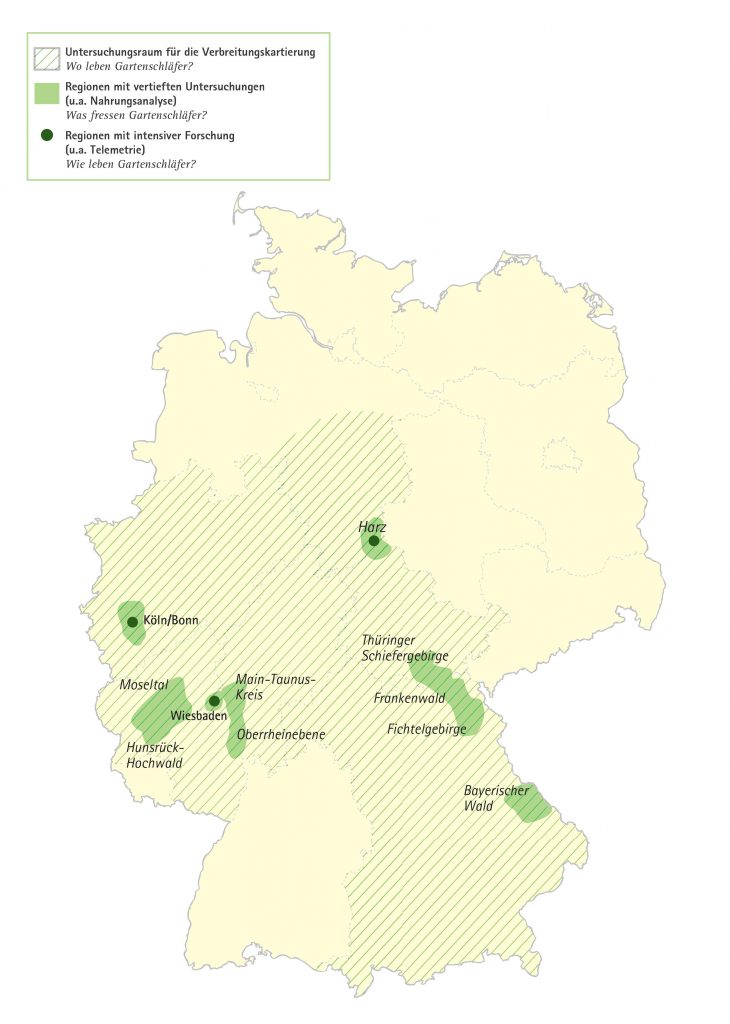The project areas
As different as the garden dormouse habitats are, also the study areas must be very diverse. Only in this way can we trace the causes of the garden dormouse disappearance.
The project areas include both the distribution centre in southwest Germany and the current peripheral regions of the garden dormouse distribution. Thus, the different garden dormouse habitats are reflected in the project. In this way, the populations and conditions of the individual areas can be compared well with each other. In addition, the declines are more clearly and faster noticeable in the peripheral regions of distribution, so they are probably easier to detect.
Bavaria
The main focus of the garden dormouse distribution in Bavaria – and thus also the project area– is situated in the north-eastern Bavarian uplands: Frankenwald (Franconian Forest), Fichtelgebirge (Fichtel Mountains), Bavarian Forest and Upper Palatine Forest. There, structurally rich spruce forests are populated with berry shrubs in the understory and species-rich mixed forests in the higher elevations. Important structures are screes and rock formations. Also known are deposits from some areas in the western Alpine region. Old evidence piling up in Lower Franconia in the Spessart. Very isolated, the species was formerly also found in lower elevations in many parts of Bavaria.
Hesse
In Hesse, according to the current knowledge, the garden dormouse is mainly located along the Rhine and Main River in orchards and adjacent shrubs, as well as in residential and peripheral areas, where the garden dormouse lives in close vicinity to people in houses, arks and gardens. South of the Main River the dormice occur in the district of Groß-Gerau, there are individual evidences from the Forest of Odes. There are also reports from the fringes of Frankfurt and the Main valley. From the rest of Hesse, evidence is sparse and outdated.
The project areas include the city of Wiesbaden and its peripheral regions, as well as the adjacent Main-Taunus-district. In Wiesbaden, the garden dormouse lives in the middle of the city in the attics of buildings, balconies and in gardens, also in fringes in allotment gardens and meadow orchards. They find similar habitats in the Main-Taunus-district.
Lower Saxony
The project area of the BUND Lower Saxony for the detection of the garden dormouse is the Harz Mountains with the Harz National Park in the South of Lower Saxony.
Here is the only stable occurrence in Lower Saxony. The Harz Mountains are a diverse and thus attractive habitat with coniferous and deciduous forests, dwarf shrub heath, fenlands and flowing waters. But the most important structures for the garden dormice are the existing rocky structures and screes, which offer hiding places especially for hibernation.
North Rhine-Westphalia
The currently known distribution in North Rhine-Westphalia ranges along the Rhine Valley in the conurbation of Cologne-Bonn. There are occurrences in Bonn, the Rhine-Sieg district, Cologne and Leverkusen. The project area is about 400 km² large. The garden dormice are mainly found in gardens and allotment gardens, parks, natural bushes and forest edges. Allotment gardeners often encounter them as users of bowers and fruit trees. The animals stand out in the gardens and suburban settlements mainly because of their loud high whistles and can sometimes even be observed well.
Rhineland-Palatinate
In the whole of Rhineland-Palatinate, possibly with the exception of the northern areas (Eifel, Bergisch-Sauerland Mountains, Westerwald), the garden dormouse is still common according to the available reports. However, this has not been systematically investigated. Reports from all over Rhineland-Palatinate should therefore form the basis for an inventory.
In three selected project regions, the occurrence is to be examined in depth:
(1) The project region in the Hunsrück-Hochwald National Park covers 91 km² in the west of Rhineland-Palatinate. Extensive cool-moist forests characterize the low mountain range on the hills of the Hunsrück, which reach on the Erbeskopf 816 m above sea level. Mixed beech forests, but also spruce forests, slate heaps and rock formations, also marshy areas, so-called slope ruptures, are typical of the Hunsrück. Where in detail the garden dormouse occurs here, shall be clarified in the context of the project.
(2) The middle Moselle valley has been shaped by mankind since the Pre-Roman era. Characteristic is the constant change of the landscape. Steep undercut banks, which are wooded or bear the typical steep slope viticulture, alternate with flat point bars, on which orchards or cities and villages with gardens stand. Garden dormice were historically and currently observed frequently in the Trier region. Single announcements are in Moselle valley in orchards and old quarries.
(3) The Upper Rhine lowland, which extends along the Rhine and the mouth of the Moselle in Rhineland-Palatinate, is about 115 km long and 25 km wide. It is densely covered with towns and villages and predominantly characterized by intensive agriculture and viticulture. The garden dormouse has a frequent occurrence in gardens, forests and orchards.
Thuringia
Current evidence from Thuringia originates almost exclusively from the Thuringian Slate Mountains. Further focal points and thus project areas are the North-western Thuringian Forest, Meininger calcareous plates, the region around the Hainich, Ohm mountains and the southern Harz. The majority of the recent sightings and carcasses found come from former slate mining areas. The garden dormouse could be detected very often in waste places. Further evidence proves it is distributed in the for the high altitudes of the Thuringian Mountains typical forest spruce monocultures.
